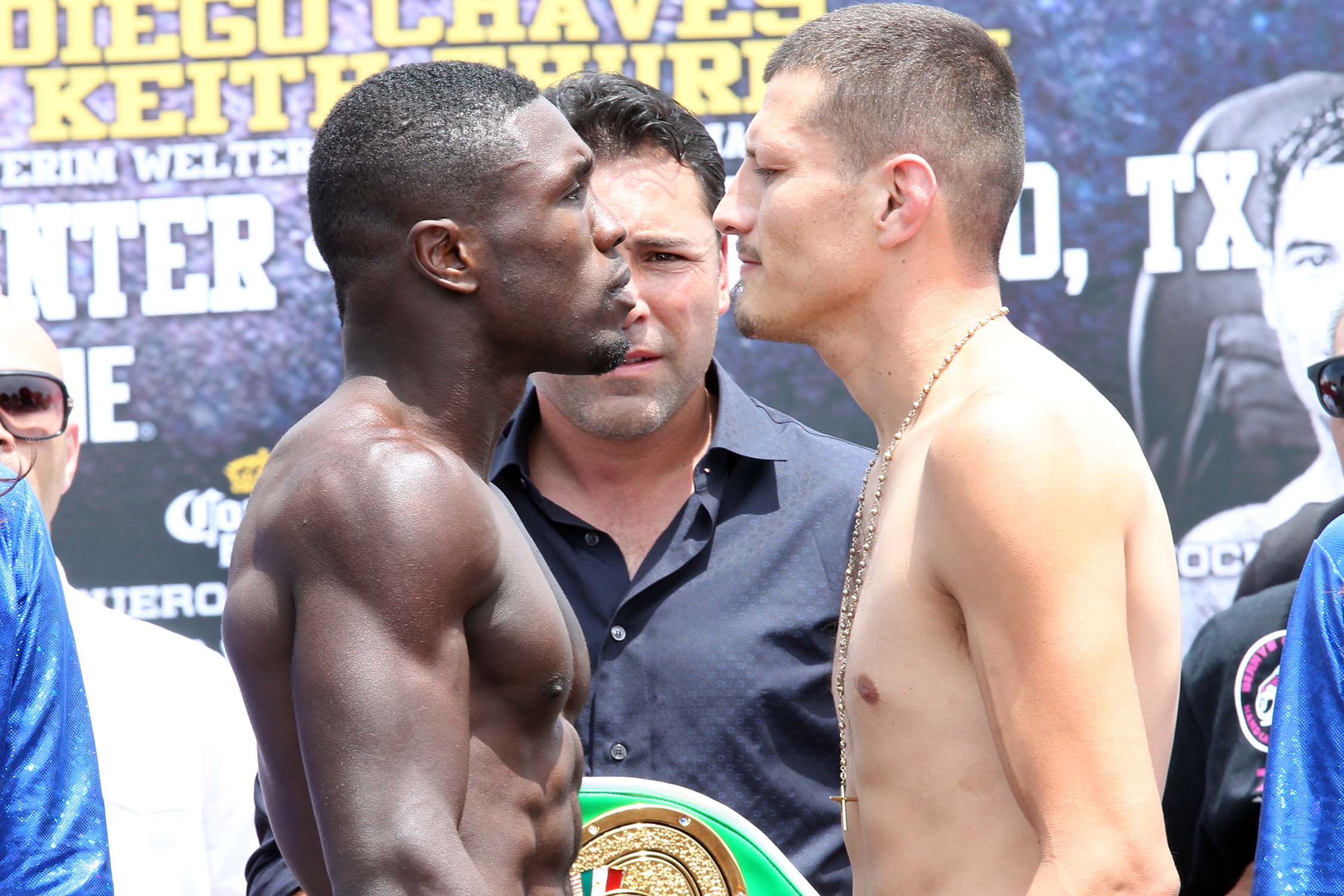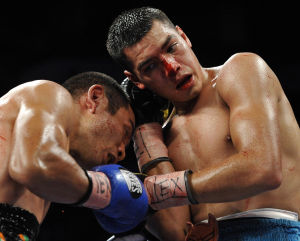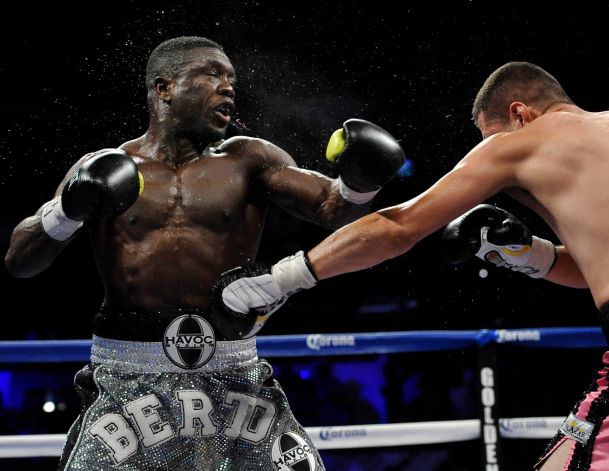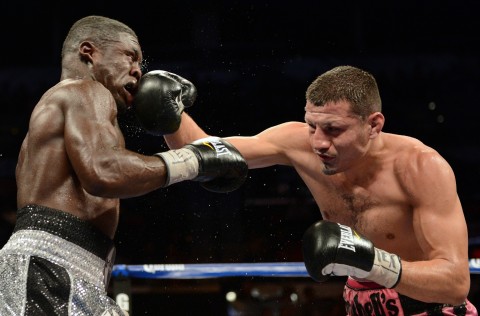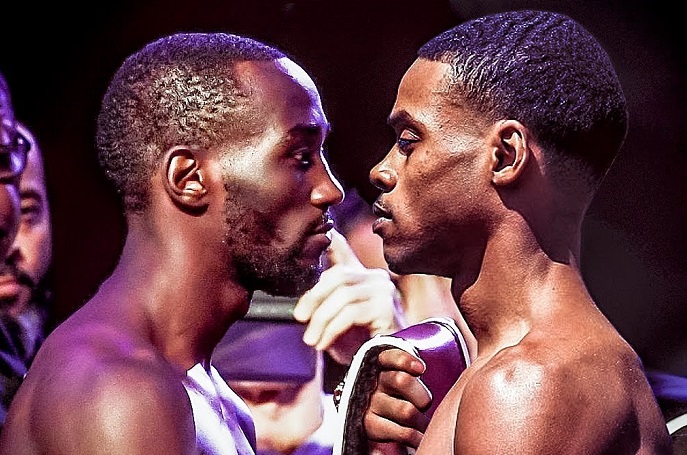Texas Shootouts: Berto vs Soto Karass
Summer can be a cruel season for boxing fans, with July and August usually offering slim pickings in the way of entertaining scraps, and 2013 seemed well on its way to continuing that trend. However, the Knockout Kings 2 boxing card, staged at San Antonio’s AT&T Center last night, helped to turn that expectation on its head with some alluring, if not stellar, matchmaking. The triple-header delivered plenty of drama and excitement, waking fight fans from their summer stupor.
On the drive to San Antonio from a Mexican border town the day before I stopped for gas at a service station in Cotulla (population, 5000) where I was given a primer on the Texas natural gas boom by a couple of rugged, massively built drillers. Standing under the hot Texan sun with the temperature hovering around the 100 degree mark, they wore dirty overalls, cowboy boots and Oakley sunglasses. Once inside the nearby convenience store, and as they expounded on the difficulties of finding a quality “titty bar” deep in the south of Texas, they removed their sunglasses and I was struck by the stark, un-tanned portion of skin surrounding their eyes. I kept thinking they looked like the meanest raccoons I’d ever seen.
And at the AT&T Center the next day I kept running into raccoon-faced hulks nearly everywhere I went. But I couldn’t pin all of them as drillers; many of them were too well-dressed, looking more the insurance or banker type than anything else. Some, like the baby-boomers sitting in the row in front of me, had just returned from a simmering day at the golf course. Yet others seemed every bit the successful rancher, their outfits consisting of mint jeans, classy cowboy hats and expensive boots. And I found it intriguing that, at least in the neighborhood of section 126 where I sat, two tiers up from ringside, there were several groups of attractive females spending their girls’ night out at the fights. Were they keen on watching some muscular men who didn’t look like racoons duke it out?
Before the Anthony Dirrell vs. Anthony Hanshaw supporting fight, something else caught my attention: a rare sighting of boxing’s most intriguing man, Al Haymon, infamous for his refusals to grant interviews and an unparalleled capacity to elude photographers. During the non-televised portion of the show I caught glimpses of him time and again as he worked the floor; taller and slimmer in person than pictures let on, he cuts an imposing figure despite his calm demeanor. Unescorted and unaided, he seamlessly made his way through aisles cramped by ushers and security types, like an invisible Moses making his way through the Red Sea. He seemed particularly pleased with Dirrell’s hammering of Hanshaw inside of three rounds.
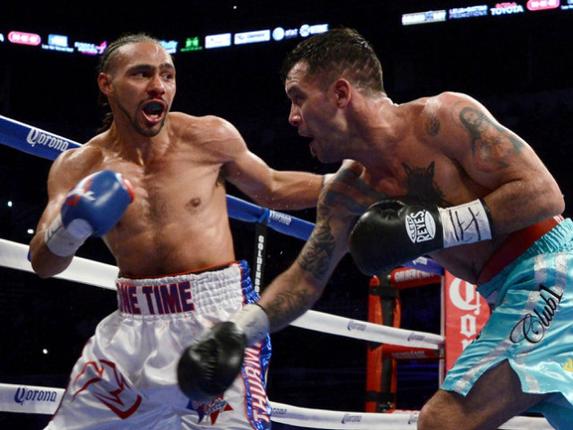
The first televised bout of the evening pitted two welterweight sluggers in Keith “One Time” Thurman, out of Florida, and Diego Chaves, out of Argentina. Going into this fight much was made of the fact both guys possess commendable punching power, and in the first two rounds this factor came fully into play; the young prospects wasted little time getting things going, lashing out at each other from the opening bell like a pair of starved lions fighting over some dead gazelle’s remains.
There was a feeling that someone would soon bite the dust if things carried on like that, but the shots that drew the sharpest gasps were those thrown by the heavy-fisted Argentine. It took only a couple of rounds for everyone, including Thurman, to realize this kind of contest clearly favoured Chaves, as his thudding overhand rights crashed on Keith time and again, rocking him almost every time.
But Thurman, who passed the chin examination with flying colours, turned things around by letting Chaves initiate contact so he could counterpunch with his own heavy shots. The new strategy served the Floridian prospect well, as he soundly won the middle rounds and even scored a body-shot knockdown in round nine. Things came to an end in round ten, when the referee granted Keith a TKO victory given that a dazed Chaves, perhaps still hurting from that left to the liver, was unable to continue following a barrage of punches. “One Time” Thurman, whose career has been smartly handled and whose talent has been carefully nurtured, now finds himself in a prominent position in the packed 147-pound division.
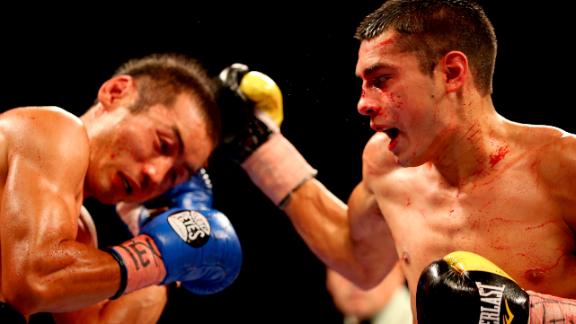
Notwithstanding Thurman’s exciting come-from-behind victory, and despite not occupying the headlining spot, the match featuring local action hero Omar Figueroa and Japan’s Nihito Arakawa is the one those in attendance are most likely to remember for years to come. Figueroa, who entered the boxing public’s consciousness with his first-round drubbing of Abner Cotto on the Alvarez vs Trout undercard, strode to the ring sporting vintage Spurs colours to the exultant cheers of his fellow Texans.
Figueroa vs Arakawa was a contest of wills, with both fighters engaging with complete disregard for safety and thinking only of earning victory in the hardest and most painful way possible. Throughout twelve of the toughest rounds yet fought in 2013, sweat and blood flew while punches landed at a frantic pace, enthralling the audience with violence and gore. If the undefeated 23-year-old Figueroa held the edge in power, the 31-year-old Arakawa more than made up for this deficit with his incredible chin and tremendous heart. Vicious exchanges took place on every inch of the ring, and the local fighter’s grit drew as much admiration from those watching as the Asian’s relentless aggression.
“Panterita” Figueroa has a reputation as something of a knockout artist, and during the first few minutes of the contest he tried his best to validate it. However, Nihito’s durability allowed him to withstand a second round knockdown, and to weather Figueroa’s countless hooks upstairs and myriad body blows, while coming back with combinations of his own. In round three what seemed to be a familiar story took an unexpected twist, when a headbutt cut Figueroa’s nose bridge and sent blood pouring down his face. This was the first time Figueroa bled in a fight, and his reaction to the event was not optimal.
Alternating shouts of “No te me rajes, huerco!” and “Chíngatelo, cabrón!” reached me from a couple of rows back. Figueroa, clearly rattled, did eventually collect himself and came back with a vengeance, unleashing an onslaught and sweeping the middle rounds by landing the more telling blows. Even if the Japanese fighter was the one pressing forward and throwing punches in bunches, he didn’t possess the power to faze Figueroa, much less take the lead on the scorecards.
A standing eight-count in round eight punctuated what an ecstatic audience felt in their bones: Figueroa was in control and could win the fight despite his opponent practically bathing in the Texan’s blood which still poured from above his nose. “Panterita” tried everything he could think of to score the coveted knockout: he switched from orthodox to southpaw, he threw overhand rights and turbulent left hooks, he fired the uppercut from way outside and from intimately close quarters, he flurried with frenzy. Ultimately, nothing could deter Arakawa. The fighters traded shots viciously during the twelfth and final stanza, with the roar of the crowd urging them further. Upon the ringing of the final bell, the audience broke into a standing ovation in recognition of the two warriors, and the reading of the scorecards—all three heavily in favour of Figueroa—gave way to a raucous celebration for Omar’s toughest win to date.
After the heart-pounding war between Figueroa and Arakawa, there was, perhaps unavoidably, a sense of anti-climax in the stands at the AT&T Center as Andre Berto and Jesus Soto Karass made their way to the ring. We had just witnessed one of the most rousing brawls of the year. As good as the main event promised to be, the question in everyone’s mind was: how could it possibly match the previous fight, let alone top it?
That Berto vs Soto Karass seemed to have a predetermined outcome didn’t help. Berto, fighting for the first time since Robert Guerrero outhustled him last November, was expected to prevail over the crude and unheralded Soto Karass. While many thought of Soto Karass as a stiff challenge, they also considered him a very probable win column for a former champion in desperate need of rehabilitation. With Showtime’s primetime broadcast team cued up and an enthusiastic crowd of ten thousand on hand — a crowd likely dwarfing the combined number of ticketholders who ever attended a Berto event in his home state of Florida — the stage was set for Andre’s comeback.
Moments from the opening bell, I tried to cajole the baby-boomer in front of me into a wager. I proffered 2-to-1 odds that Berto would end things inside of four rounds, but he ignored me; he was more interested in using his iPhone to snap pictures of the curvaceous blonde sitting across the aisle. I advertised the same offer to the hollering Mexican behind me, thinking my countryman wouldn’t let me down, but he didn’t even hear me as he was too busy bellowing pugilistic advice to Soto Karass before the bout had even started.
As soon as the first round ended, I was relieved no one took my action; Berto, it was clear, was in for a long night. He didn’t look slow, but definitely off rhythm, jumpy as hell, maybe even nervous. The plodding Soto Karass drove home overhand rights that landed on Berto’s visage and rocked him, making him smile shyly, more in the “I can’t believe I got tagged like that,” vein than the “You got nothing I can’t handle, bro’” he wanted to convey.
The cold, thudding sound of Soto Karass’ gloves hitting Andre Berto’s flesh resonated in the largely silent venue. The public had been drained by Figueroa vs Arakawa and had little left to invest in what was now happening inside the roped square. While Berto had the edge in speed, ducking incoming fire and retaliating with hard counter-punches from his half-shoulder roll, an undeterred Soto Karass pressed the action, forcing Andre into a brawl and determined to avoid at any cost the boxing match he was certain to lose.
In the fourth Berto went down hard. It wasn’t due to contact, though; a sweeping left hook of his came nowhere near close to hitting Soto Karass, but his own arm’s momentum dropped Berto, who ended up hurting his right shoulder. For the rest of the fight Berto fought on slippery feet, constantly off balance and struggling to land clean shots. “El Renuente” Soto Karass pressed on, connecting punches to Berto’s head and body, and taking the lead on the scorecards by the championship rounds.
In the eleventh a low blow by Berto dropped Soto Karass to his knee, an incident the referee mistook for a knockdown. I glanced quickly at my companions in the stands to assess their reactions and found the lustful baby-boomer seething with contempt for the ref, while the Mexican fan behind me questioned out loud the reputation of the referee’s mom. The fight was now a close one, with Berto doing enough to stay in it while Soto Karass continued closing the distance. The combatants traded nasty uppercuts on the inside and punishing right-crosses from a distance; the mounting intensity of hostilities finally succeeded in bridging the spectator’s detachment from the fight.
In the opening seconds of the twelfth Soto Karass landed a perfectly timed left hook right on the button, dropping Berto instantly and bringing the crowd to its feet. It was a moment of partial vindication for those who assembled the second “Knockout Kings” card, but they were probably disappointed it was the Mexican who scored the knockout. Andre Berto, advised by the aforementioned Al Haymon was supposed to jump back into title contention with a win over Soto Karass, but “El Renuente” cruelly wrecked those plans with that wicked hook. The crowd couldn’t care less, though. Even though a portion of ticket-holders had abandoned the stands for some San Antonio nightlife before the main event was over, those who remained rejoiced at Soto Karass’ upset.
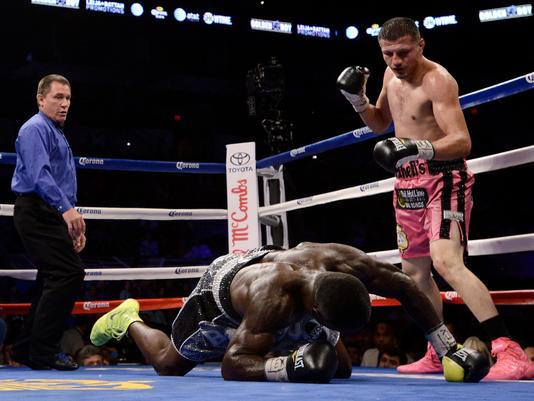
Ever since Berto first began headlining HBO broadcasts many had voiced concerns that the Floridian was more hype than substance, and his performance against Soto Karass lends a certain credence to their argument. The Floridian’s losses to Victor Ortiz and Robert Guerrero were thrilling affairs which, with perhaps a bit more push from Berto, could’ve turned out differently. But the loss against Soto Karass could be the final nail in the coffin. Soto Karass is, from a technical point of view, a very limited fighter, his chief assets an unbreakable will and decent punching power. If Berto lost decisively to a fighter like Soto Karass, that says a lot about Berto’s limitations too: porous defense, concentration lapses, and more importantly, no mastering of posture and footwork fundamentals.
But if Andre Berto emerged the loser in San Antonio, Keith Thurman and Omar Figueroa were the big winners, not to mention the paying public, who got their money’s worth and then some. The Soto Karass case is a bit trickier, since his win will be perceived only partially as a turning point, given that it exists largely as an exposé of Berto’s deficiencies. Nonetheless, the Mexican stuck to his game plan and showed plenty of determination, and thus should be rewarded with another high-profile matchup. However, there’s little reason to believe he has suddenly arrived as a force to be reckoned with at 147-pounds. Whatever happens next in the career of the Los Mochis, Sinaloa native, he has proved his violent stylings are more than suited to the discerning taste of Texan boxing fans looking for drama on a hot summer night.
– Rafael Garcia

